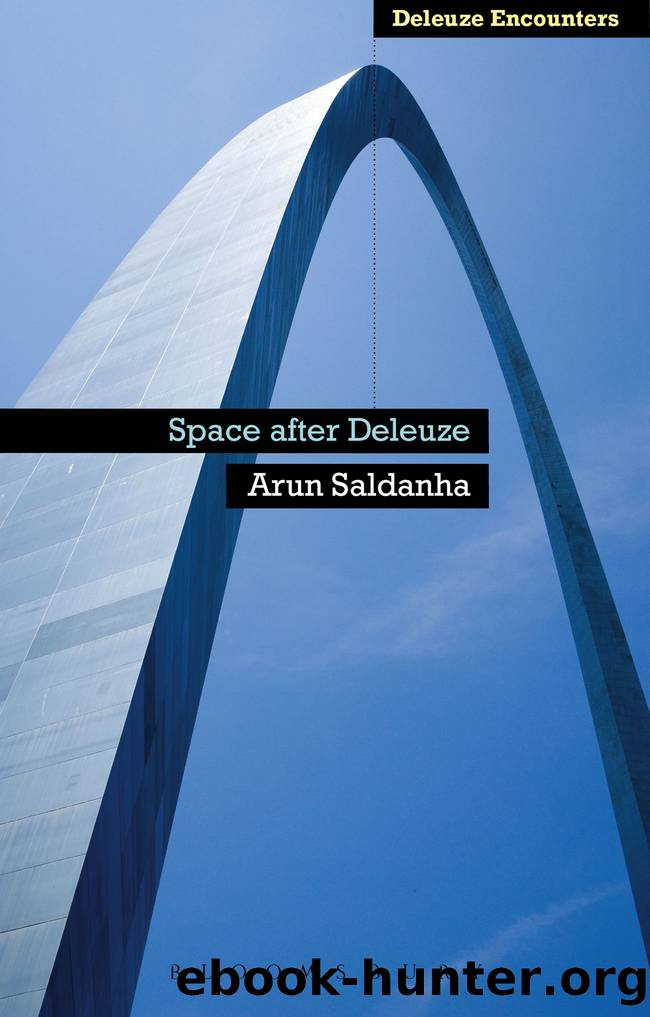Space After Deleuze by Arun Saldanha;

Author:Arun Saldanha; [Saldanha, Arun]
Language: eng
Format: epub
ISBN: 9781441179838
Publisher: Bloomsbury UK
Published: 2017-02-25T00:00:00+00:00
Refrains
Striation is not simply the construction of places in the geographical sense but the physical and ideological framework by which place construction becomes possible. It is specific not to the human species but to stratified society. Territorialization, meanwhile, is a more general term and refers to any activities whereby an animal makes boundaries. We can call âplaceâ the specifically human kind of territoriality, but there are important qualifications. First, human territoriality repeats some animal territoriality through its phylogenetic line. Second, territories preexist the species that inhabit them yet are not simply programmed within its genome. Territories derive from the interplay of bodies with their environments, flows of matter and energy, deeper bio- and geophysical phyla, even the cosmos itself (think of how albatrosses are drawn into an interhemispheric territoriality). Third, and perhaps most original in Deleuze and Guattariâs rethinking of territory, boundaries are themselves assemblages. Territorialization requires a dynamic coming-together of heterogeneous components set loose from elsewhere. Something is deterritorialized only to be reterritorialized within a new configuration. Following the theorization of difference and individuation in Difference and Repetition most Deleuzians avoid calling this dynamism a âdialecticâ between movement and stasis, or wave and particle, or becoming and being, because there is no higher identity that would hold the two âsidesâ or âpolesâ in mutually negating opposition. The consistency of a territory â a major concept in A Thousand Plateaus and What is Philosophy? â is not a higher identity but a specific âway of holding togetherâ in which all components play an active and complementary role, a local mannerism of reality, a symphony. What makes an assemblage like a territory hold together are its lines of flight, not its essence or structure (ATP 327â28). Deleuze and Guattari largely favor deterritorialization because it is the more basic and repressed principle. But a refrain in this book has been that it would be wrong to see deterritorialization as a straightforward ethical or epistemological objective because its creative momentum intrinsically lends itself to the return of essence and transcendence.
The refrains plateau develops this dynamic sense of territory and suggests that the place-making fundamental to human life is a local expression of a deeper and older process shared with mammals, birds, and insects. The plateauâs main target is not only phenomenology and existentialism, which define human place as fundamentally different from animal and plant territorialities, but the hegemonic obsessions with fitness and adaptation that usually inform the territory concept. While for biologists like Karl Lorenz birdsong is explained by its function to erect boundaries and advertise masculinity, for Deleuze and Guattari it is first and foremost an aesthetic process produced as part â the most deterritorialized part â of an assemblage or desiring-machine (ATP 315). Birdsong is not like music, it is music. For neo-Darwinian dogma, in a thinly veiled extrapolation from the real-world striations of markets and sovereignty, the territorialities of sex and habitat in animals are predictable phenotypical extensions of a speciesâ DNA. Instead, for Deleuze and Guattari, a territory only emerges contingently from the gestures and signs (urine, song, dance) in and around it.
Download
This site does not store any files on its server. We only index and link to content provided by other sites. Please contact the content providers to delete copyright contents if any and email us, we'll remove relevant links or contents immediately.
Man-made Catastrophes and Risk Information Concealment by Dmitry Chernov & Didier Sornette(5921)
The Revenge of Geography: What the Map Tells Us About Coming Conflicts and the Battle Against Fate by Kaplan Robert D(4034)
Zero Waste Home by Bea Johnson(3777)
COSMOS by Carl Sagan(3554)
Good by S. Walden(3485)
In a Sunburned Country by Bill Bryson(3481)
The Fate of Rome: Climate, Disease, and the End of an Empire (The Princeton History of the Ancient World) by Kyle Harper(3003)
A Wilder Time by William E. Glassley(2818)
Camino Island by John Grisham(2762)
The Ogre by Doug Scott(2631)
Organic Mushroom Farming and Mycoremediation by Tradd Cotter(2626)
Human Dynamics Research in Smart and Connected Communities by Shih-Lung Shaw & Daniel Sui(2465)
Energy Myths and Realities by Vaclav Smil(2438)
The Traveler's Gift by Andy Andrews(2409)
9781803241661-PYTHON FOR ARCGIS PRO by Unknown(2321)
Inside the Middle East by Avi Melamed(2305)
Birds of New Guinea by Pratt Thane K.; Beehler Bruce M.; Anderton John C(2223)
A History of Warfare by John Keegan(2185)
Ultimate Navigation Manual by Lyle Brotherton(2129)
